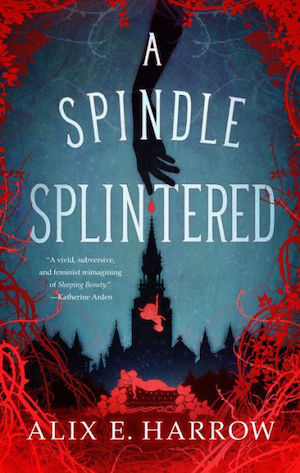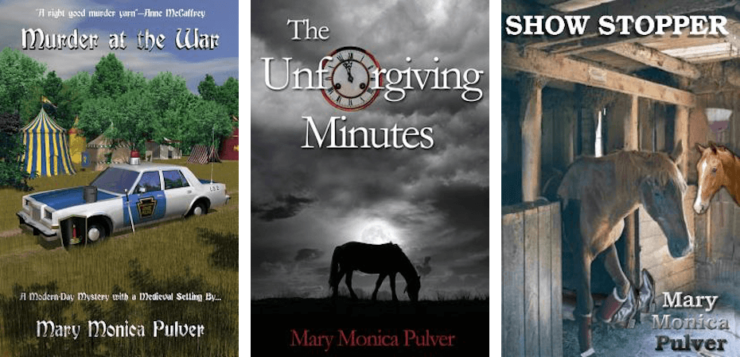We all have commenter Fernhunter to thank for this post. Not too long ago, they recommended Mary Monica Pulver’s Price and Brichter series of murder mysteries as relevant to my interest. As they put it, “He’s a cop. She raises and shows Arabians. They are in the SCA.” (The Society for Creative Anachronism, for those not in the know.)
I could swear that I had at least read Show Stopper. I have been aware of Murder at the War since shortly after it was published in 1988, but I had never actually got hold of a copy. Then lo and behold, I discovered that the whole series is available in ebook. And one fine weekend, I snagged the lot.
Whatever I read that I had thought was Show Stopper was something else altogether, probably by Jane Smiley. Because I would surely have remembered that particular novel. It speaks to me in ways that I will get into in just a bit.
I love a good murder mystery. I have never been tempted to write one, and that’s part of why I adore the genre so much. I can read it as a reader. I don’t get the urge to either edit it or write my own. It’s pure pleasure.
And oh, are these five novels a pleasure. The characterization is deft, the settings are distinctive, and the mysteries are nicely done. There’s organized crime—Peter Brichter, the male half of the duo, is a detective in the Organized Crime Unit of a small city in the Midwest. There’s murder most foul, cruel and unnatural. There are deep, dark family secrets on a downright Gothic estate complete with secret passages and hidden treasure. There’s the SCA, with a whole delightful murder mystery set at the Pennsic War.
Of course there are horses. Kori Price Brichter, the female half of the duo, breeds and shows Arabians. The SCA volume, Murder at the War, barely mentions them at all, but they’re very much a part of the rest of the series, and the final entry, Show Stopper, is set at an Arabian show. A painfully accurate, deeply truly true example thereof.
It’s abundantly clear that Pulver is a horse person. I only wanted to smack her a couple of times, which is pretty impressive over a five-volume series. She knows the glory and the pain of horse ownership, and she understands what a horse is to a horse person. She also does a good job of portraying the suffering horse husband. Peter is Not a horse person, but he learns early and thoroughly that if he wants Kori, the horses are a big part of the package.
The one thing that really made me sit up and yowl was the episode in the country house mystery, Original Sin, when Kori goes out in a blizzard to feed the horses and gets severely sidetracked. She ends up not even trying to get to the barn, and leaves them hungry until morning.
No. I’m sorry. I don’t care if there’s a body in the library and the groom is nearly dead of exposure. There’s a whole houseful of guests to look after them. The horses only have Kori. She has to get her booty out there, and she has to feed them. They can’t just skip a meal if all they get is two a day. That way, especially for sensitive show stock, lies a vet call and possible illness or death.
I mean. She lives in the Midwest. She knows there’s a big storm coming. She can run a rope to the barn so she can find her way there in the whiteout. She will do what she has to do in order to make sure the horses stay on their schedule. Or at the very least, she’ll put up a serious fight when Peter gets overprotective and tries to stop her from going back out to the barn.
But really, that’s the only part that had me up and squawking. By the time I got to Show Stopper, I was ready for a grand read, and I got it.
The thing to understand about the series is that it’s set in the late Eighties and early Nineties. The big boom in Arabian horses was starting to die down and would soon collapse in a heap of rubble, but there was still a lot of money in prime show stock. As in, a hundred thousand dollars for a nice stallion, and half a million for a top broodmare.
That’s the horse world Kori lives in. Then, in Show Stopper, she ventures into a new discipline for the breed: dressage.
Arabian showing in the boom years of the Seventies and Eighties was mostly about the beauty contest. Showing at halter—presenting horses in a big arena, in a particular stance, with a particular arch of the neck and stretch of the head—was big, big business. To the point that rockstar trainers could take just about anything out there and win big trophies and even bigger bucks.
Buy the Book


A Spindle Splintered
These trainers almost never rode. That’s not what they were about. But the more it went on, the more extreme the production got, and the further the horses diverged from functional conformation.
Quite a few people in the breed started to rebel against the halter aesthetic. One of the things they started to get into was the diametrical opposite of the stand up and look pretty principle: the ancient art of dressage. This was just starting to become a thing when Pulver wrote Show Stopper, and Kori has just been getting into dressage for a couple of years, which is about right for a novel published in 1992. The fact that the villain of the novel is one of those big-hair, big-whip, take ‘em out behind the barn in a heavy blanket and whip ‘em till they submit trainers is strikingly, painfully accurate, and it is delicious to see what happens to him.
I lived this. I rode Arabians in the Eighties, and showed them in dressage, not only at breed shows but in open dressage shows against more conventional dressage-type horses. I got to see firsthand what Pulver writes about, on both sides of the show divide. And I watched the whole thing evolve, or devolve, through the Nineties and into the new millennium. I caught myself wondering near the end of Show Stopper, considering the identity and occupation of the murderer, what Pulver thought of “Heckuva Job Brownie” and the debacle of Katrina.
Brownie, you see, had run the Arabian Horse Association before he became a political appointee—and he had run it into the ground. He brought the same skills, or lack thereof, to FEMA and the disaster in New Orleans.
It’s not just the bigger picture that made me love this book. The introduction mentions Pulver’s dressage instructor, Kurt Jordi, and he’s the model for Kori’s instructor in the book, who is referred to as “The Prussian.” I wept with laughter at the description of him, because that was Kurt, right down to his signature phrase: “You must find your tailbone. Find your tailbone! Then you can ride!”
I met him three years after the book came out, when I bought a mare from him. Kurt, you see, bred Lipizzans. He had a small, choice herd, of similar quality to Kori’s small herd of Arabians. Buying Lipizzans then as now took dedication, research, and a lot of contacts all over the place. My search led me to Kurt’s sales list, and I bought the mare from a video, which I do not recommend, do not try this at home, but I was young(ish) and intrepid and it’s a tiny breed and we all know each other and our horses, so I did it.
Kurt and his wife Margrit brought her down in their big black trailer with LIPIZZAN in six-foot white letters on the side. They stayed for a couple of days, and they were delightful company.
What is particularly hilarious to me now, having read Pulver, is that I took them to a local Arabian farm to see the sire of my half-Lipizzan colt. Kurt cast a cold eye on the pastures full of beautiful faery horses. “Not too bad,” he said with the slightest hint of a sneer. “But they’re not Lipizzans.”
I can just imagine what Kori would have said to that.
As it happens, the Jordi connection is still strong here. That first mare and I were not soulmates, though she taught me a great deal. I sold her to a lady who loved her and understood her and kept her until she died at a noble and considerable age, but I still really liked that particular horse family for its beauty, its movement, and its spirit. After a number of years of searching and shopping, I bred a filly by the mare’s lovely nephew. She is now a grown mare, and she is still with me. And just as I write this, that filly’s brother by the same sire is on a horse van, coming down to me from a few states over, to be my new farm stallion.
I owe Kurt for that, for breeding beautiful horses, and for teaching many a rider to find their tailbone. I did indeed manage to find mine.
As you can see, I had a wonderful time reading Show Stopper and its prequels. My only regret is that there are no more volumes in the series. Pulver writes a good mystery and great characters. And she gets the horses right.
Thank you, Fernhunter, for a most excellent recommendation.
Judith Tarr is a lifelong horse person. She supports her habit by writing works of fantasy and science fiction as well as historical novels, many of which have been published as ebooks. She’s written a primer for writers who want to write about horses: Writing Horses: The Fine Art of Getting It Right. She lives near Tucson, Arizona with a herd of Lipizzans, a clowder of cats, and a blue-eyed dog.










